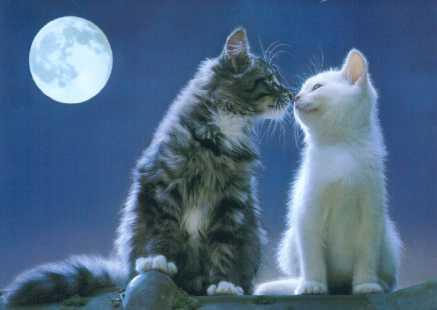
They were at a party when they saw each other for the first time. The music dimmed. Everyone else ceased to exist. The world changed. They knew, from the soles of their feet to the pits of their stomachs to the split-ends of every hair follicle that they were destined to be together. They just KNEW.
These days we roll our eyes at this attitude. Love at First Sight just doesn’t exist, because love is based on trust, understanding and familiarity. That’s how we define it, so how can a person possibly love another in the truest sense of the word without even having spoken to the object of their affection?
Attraction at first sight? Sure. Attraction that leads to a stable and loving relationship after a lengthy courtship period has taken place? Absolutely. People inserting the emotions of their current relationship into past recollections and tricking their memories into thinking they loved their partner right from the very start? Complicated, but it hangs together psychologically.
But actual, genuine love at first sight? No way.
Yet all of that is dealing with love in the real world – a messy, complicated, time-consuming, life-long commitment. But what about love in fiction? Can you get away with a couple instantaneously falling in love in that context? I would argue – yes.
Sometimes having two characters fall in love at first sight is a necessary evil in fiction. It might happen just to kick the plot into gear. Your hero/heroine could need some extra motivation to do what they gotta do, and an attractive partner waiting at the finish line is certainly an enticing carrot to dangle in from of them. Maybe you're trying to deconstruct the entire notion of falling in love at first sight and expose it for a shallow and superficial hoax. You may just want to infuse your story with a minor romantic subplot, just to spice things up a little bit.
To put it bluntly, the Love at First Sight trope can be a simple way of forging an emotional bond between two characters so that you can efficiently move on to other things, whether it be exploring the notion of Love at First Sight, or using it as one small part of a much larger story. And I honestly believe that in these cases the trope can be pulled off, as long as you know what you’re doing.
So let’s have a look at six of the most illustrative uses of this trope: those that embrace Love at First Sight whole-heartedly.
1. Geraldine and Harry from The Vicar of Dibley
Here’s an example of Love at First Sight played straight, but in such a way that it feels completely natural and deserved. Geraldine and Harry meet, fall in love, and get married all in the space of two episodes, but there’s no doubt in anyone’s mind that they’re going to live happily ever after.
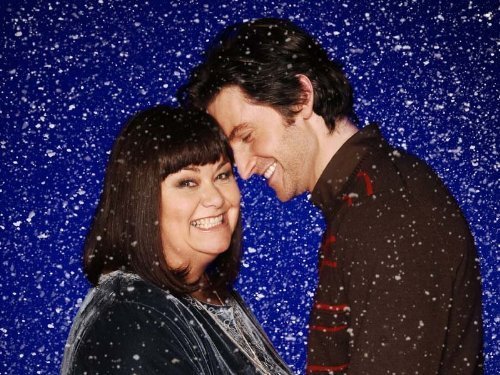
Here’s the setup: Geraldine Granger has been the vicar of Dibley for a decade, officiating over dozens of weddings and bearing witness to hundreds of happy couples. She has a rewarding career as a vicar, a wide array of friends, and plenty of chocolate stashed away in the fridge.
Most importantly, she’s made her peace with the fact that she may never marry. As her verger Alice points out to her, she’s already married to a village that loves, respects and cherishes her. And that’s okay.
But Geraldine is... how do I put it? Desperate for a man. It’s important to point out that though Geraldine is not defined by this search, she certainly embodies it. She may have plenty of things going on in her life as The Caretaker to the village of Dibley (which she generously describes as an insane asylum), but the long-running crux of her characterization is her very deep desire to find a life partner.
This however, is not on her mind when she heads over to a newly-bought cottage to introduce herself to the Londoner that’s just moved in. According to her, the ever-increasing flow of city-slickers to the quaint village of Dibley is destroying the community. So she heads over the cottage, determined to give its inhabitant a piece of her mind.
The door is opened by Harry Kennedy. He’s charming. He’s flirty. He’s played by Richard Armitage. Geraldine is instantly smitten – and it looks as though Harry is pretty interested as well.
Why does it work so well? For two reasons, the first being the aforementioned characterization of Geraldine, and the second being the nature of the genre.
Because these are the very final episodes of The Vicar of Dibley, and having seen her struggle through so many misunderstandings and heartaches and tribulations, the audience is more than ready for Geraldine to get her happy ending. The show has fostered enough goodwill in the audience, and made them invested enough in Geraldine’s happiness, to enable them to accept the possibility of such a whirlwind romance actually happening.
And it naturally helps that this is a comedy. In the melding of a genuine romance and comedy conventions, the writers come up with the brilliant idea of lamp-shading a typical Jane Austen novel. When Geraldine first introduces herself to Harry, they share their favourite books, with Geraldine confiding that she loves reading: “the girl [getting] swept off her feet by a handsome stranger after a terrible misunderstanding.”
Later they poke fun at the noise Emma Thompson makes in Sense and Sensibility when she realizes Hugh Grant is still single, one that Geraldine demonstrates before scoffing that she’d never make such a noise if the man of her dreams proposed.
Naturally, this is exactly how their romance unfolds: first Geraldine thinks that Harry’s sister is actually his girlfriend, and when she realizes that Harry is actually proposing to her, she makes the Emma Thompson snort/laugh/gasp/scream.
The cherry on top is that the script also makes a brave attempt to flesh out Harry as a character despite the limited time-frame. Perhaps he’s more of a Relationship Sue than not, but the storyline takes pains to point out that he and Geraldine are compatible: they not only share a sense of humour, but in a short amount of time you see them flirt, joke around, have a few disagreements, and enjoy each other’s company.
We learn the basics of his life: the books he likes, his career, his relationship with his sister, his willingness to help out other people in the village. He’s a mix of suaveness and warmth, is self-aware enough to describe his proposal as “maybe too rash or too soon or too stupid,” and even helps Geraldine be more assertive when it comes to saying “no” to her parishioners. Plus, he has the trademark Richard Armitage smoulder.
It works because we’ve waited so long for Geraldine’s happiness, we’re happy to accept Harry Kennedy as her perfect match, and the show isn’t above poking a little bit of fun at the fairytale nonsense of it all.
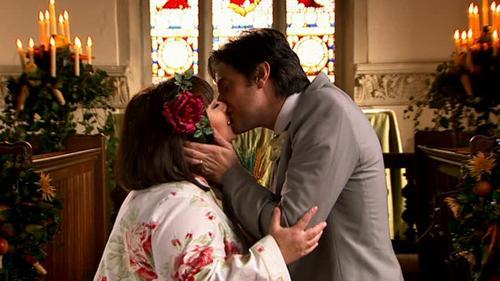
2. Anna and Hans from Frozen
The ironic thing about this example is that even though it’s ultimately a subversion of the trope, I honestly believe that the film could have gotten away with it as a straight example if it had so chosen.
Here’s the setup: Princess Anna has spent most of her life cooped up in a castle, separated from her sister and isolated from other people. If anyone’s ready to fall in love, it’s her. Prince Hans introduces himself as the youngest of twelve siblings, two of whom apparently spent two years pretending he was invisible. Yikes. He seems pretty primed and ready to fall in love as well.

Recognizing that they have a hefty bout of loneliness in common, the two of them bond instantly – through song. Never underestimate the power of a song. When people run out of words, a song allows characters to express themselves in a ways that would be impossible in a non-musical. A song allows for the passage of time, the intensity of emotions, and the complimentary nature of characters through a duet.
So Hans and Anna dance around the palace. They take their shoes off and skid over the floorboards. They hide from the guards, they stare at the stars, they finish each other’s... sandwiches. It’s adorable and funny and sweet, and if you didn’t know how this story was going to end, you could be fooled into thinking the film was trying to pull these two off as a bona-fide couple, just as they did with the old-time Disney Princesses (hey, it didn’t take much more than a song and dance for Snow White, Cinderella and Aurora to find their true loves).
But when the script calls for True Love’s Kiss, the subversion kicks in. Turns out that not only was Hans was after her wealth and kingdom the whole time, but the act of true love is one that manifests between the sisters, not Anna and Kristoff (as they mistakenly believe).
Personally, I think the twist would have worked just as well if Hans hadn’t been secretly evil, and instead for the two of them to realize that their “love” was too shallow and spontaneous to actually have any sort of power, but the fact remains that this is a nice example of how the trope can be played with.
At this point, allow me to mention Enchanted before you do. This is often held up as the original film that pokes fun at the idea of two people falling in love after nothing more than a held gaze and a duet – but people forget that it goes on to assert that three days (at most) is plenty of time to find your life partner. Not only that, but in an attempt to Pair the Spares of Prince Edward and Nancy, they depict a couple that gets married in even LESS time than Edward and Giselle initially fell in love! Talk about a Broken Aesop!
3. Christian and Satine from Moulin Rouge
You know how I talked about how musicals can gloss over the practicalities of falling in love by instead conveying heightened emotions, stylistic visuals, and the implication of time passing? Well, that’s Moulin Rouge in a nutshell.

Granted, there are some that did in fact find Christian/Satine to be shallow and unconvincing, but I think that’s missing the point of this entire movie.
Here’s the setup: Christian is newly arrived in Paris to fulfil his dream of becoming a writer. He wants to write about “truth, beauty, freedom and love”, but there’s one glaring problem – he’s never been in love. Luckily, an unconscious Argentinian falls through his roof and he gets caught up with a crowd of Bohemians rehearsing their latest play (it makes sense in context). Impressing them with his musical talent he’s whisked away to the Moulin Rouge to meet with Satine, the most beautiful courtesan of them all.
The plan is simple: get Satine to endorse their production of Spectacular Spectacular to her employer Harold Zidler. However, after a mix-up during a dance number, Satine comes to believe that Christian is the Duke – the wealthy and powerful (and incidentally, completely nameless) man who is all set to sponsor the show... in exchange for Satine’s exclusive company.
Of course, after the big song and dance number in which Christian spontaneously comes up with the tune and lyrics to Elton John’s Your Song, dances with Satine in the clouds while the moon serenades them, and sings a medley on the back (and interior) of a giant elephant, Satine is just as hopelessly in love with Christian as he is with her.
He’s a writer looking for a muse. She’s a courtesan looking for an escape (namely through establishing herself as a real actress). Clearly they need each other, and the entire movie revolves around the musical that Christian writes specifically for Satine, which in turn reflects their impromptu love story.
Now all they need to do is keep extorting the Duke for money whilst keeping their love affair a secret. Oh, and Satine is secretly dying.
Why does it work so well? Because what Moulin Rouge isn’t about love any more than it’s about beauty, truth or freedom – it’s about the idea of love (and beauty and truth and freedom). It’s that idealized pinnacle of joy and passion and rapture that’s exalted here, and that has power too – especially when it’s cut short by an early death, allowing those emotions to remained fixed at the height of their intensity. Moulin Rouge elevates that prolonged – though transient – period of ecstasy to a form of religion, or even a fetish, chased and experienced in a world that’s drenched in confetti and glitter and strobe lights.

Yet Christian and Satine fall in love quite early in the movie’s runtime, leaving the bulk of the story to revolve around all the obstacles in their way: the subterfuge, Satine’s life as a high-class prostitute, the Duke’s assassination attempts, Satine’s Break His Heart to Save Him gambit, and of course, the whole dying of consumption thing. All this makes Moulin Rouge a good example of Love at First Sight being used as a device. The falling in love doesn’t matter so much as the being in love, for that’s when the story really begins.
And it could only ever be pulled off in a Baz Luhrmann film. To get away with this type of thing you need fireworks and loud music and kinetic editing and jittery camera work and generally an over-the-top spectacular. Only in this setting can a film can ask you to believe that falling in love can be as simple as the subsequential obstacles are complicated. At some point you have to accept the madness and just go with it.
4. Edward Bloom and Sandra Templeton from Big Fish
While we’re on the subject of Ewan McGregor, there’s also Big Fish to consider. It’s not a perfect movie, and my feelings on it as a whole are summed up nicely in this review, but when it comes to depicting Love at First Sight, it knows exactly what it’s doing.
Here’s the setup: Edward Bloom works at the circus. Sandra Templeton visits the circus. You know, I don’t even have to describe it when the scene in question is right here:
From this point on Edward devotes his life to tracking down the mystery woman, finally finding her at a university and declaring his love for her outside her dormitory. Unfortunately she’s engaged, but when has that ever stopped the course of true love? Edward woos her with increasingly elaborate romantic gestures until she’s finally won over (helped by the fact that her real fiancé proves himself a bullying cad).
Why does it work so well? As with Moulin Rouge, the key here is the way in which the trope is staged. More specifically, how it exists within the context of its framing device. The entirety of Big Fish is told as a series of vignettes, with an elderly Edward Bloom telling “big fish” stories to his son. The scene above is presented as one of these tales, and therefore may or may not be exactly how events really happened.
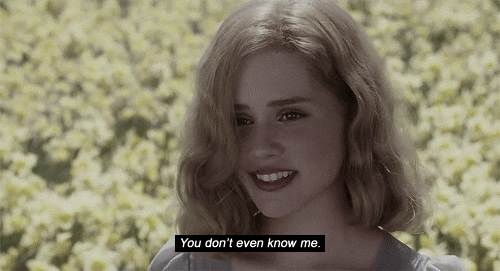 |
| Good point |
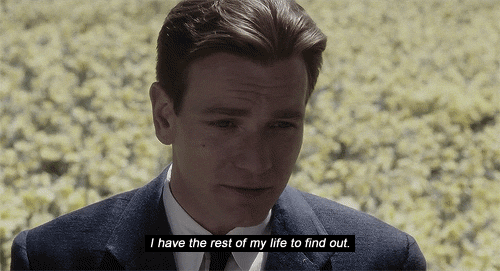 |
| Nice comeback |
You’re not being asked to accept the whimsy and magic of this moment as real, but as an idealized memory of what Edward’s first glimpse of Sandra was like.
And...that’s pretty much it really! It needs no other justification, and it helps that the film also depicts Edward and Sandra in their old age – still married and still very happy. The depiction of Love at First Sight is taken from absurd to charming, simply because the film only asks us to believe that this was how it happened in the elderly Edward’s memories.
It may not be true in substance, but it’s true in sentiment, and that makes it a quintessential portrayal of Love at First Sight.
5. Aladdin and Jasmine from Aladdin
Okay, this is it. The example of Love at First Sight played absolutely straight and which works 100%. After watching this movie there is no doubt in anyone’s minds that Aladdin and Jasmine are perfect for each other, and that their happily ever after is guaranteed. If you yourself genuinely need/want to have your couple fall in love in a matter of a few minutes, then this is how you pull it off.
Here’s the setup: Aladdin is a dirt-poor thief living in the streets of Agrabah. Jasmine is the princess of the very same city, living the life of luxury behind the palace walls. But both feel utterly trapped by their circumstances and are deeply unsatisfied with the hand they’ve been dealt.
Of course, dodging guards and scrounging for food may seem much worse than life in a gilded cage, but Jasmine’s problems aren’t to be dismissed out of hand: an Arranged Marriage to a perfect stranger is certainly not something anyone would look forward to. So Jasmine decides to take matters into her own hands and run away from home.
She’s out in the marketplace of Agrabah when Aladdin sees her for the first time. He’s instantly smitten – and then races to her rescue when an irate storekeeper tries to cut off her hand.
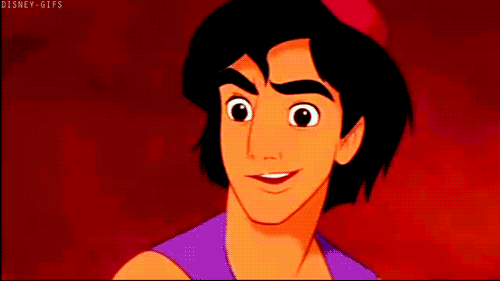
Here’s where it gets good. Jasmine isn’t just a passive observer to her own rescue. After Aladdin whispers “play along” and tries to pass her off as his crazy sister, Jasmine gets in on the act and starts bowing to Abu. All the interaction that follows only demonstrates how compatible they are: Aladdin takes her to his hideaway, Jasmine gets to impress him by vaulting over the rooftops by herself, they say the exact same word at the exact same time: “trapped.” Heck, they even entice us with an Almost Kiss.
At this point they don't even know each other's names, and yet everything is engaging and dynamic and funny – and it doesn’t hurt that they’re backlit by an incredible sunset.
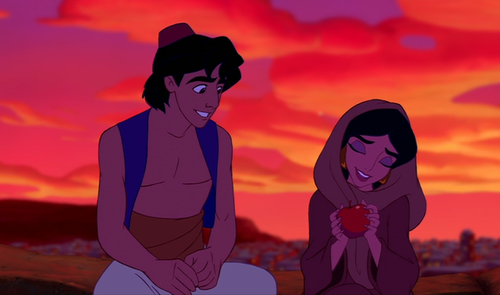
Why does it work so well? The answer is simple: the audience knows that Aladdin and Jasmine are perfect for each other well before the two of them meet. They’ve established Aladdin as a street rat with big ambitions and a heart of gold, who gives away the bread he’s just spent an entire musical number trying to steal to a pair of hungry children. They’ve depicted Jasmine as a spirited and sensitive young woman with a thirst for freedom and adventure.
Clearly they were made for each other, but before the fateful meeting actually takes place, the film is careful to depict a number of little character beats that link them together: Aladdin stares dreamingly at the palace, Jasmine articulates her longing for friends, both have an animal as their only companion, each one conveys a deep sense of loneliness, they individually manage to insult the snooty suitor that comes for Jasmine’s hand in marriage – and of course, their first meeting occurs after Jasmine (innocently) steals an apple for a hungry child. Hmm, who else do we know that gives food to hungry youngsters?
It's like the audience has been let in on a secret that the characters don't yet know, and before a single second of interaction, you can feel the impending chemistry and the gears of fate drawing them to each other. By the time they lock eyes in that busy marketplace, you’re salivating for the inevitable fireworks.
And then of course, there’s this:
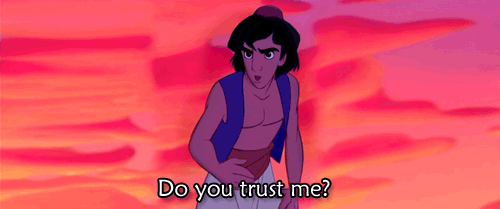
People will say that love has to involve trust and argue that Love at First Sight therefore cannot possibly exist since trust is something that has to be earned over time. You know the easiest way around this? A life-or-death situation. When Jasmine answers “yes” and takes Aladdin’s hand in this moment, you know it’s meant to be. The response to “do you trust me?” is more powerful than any number of “I love yous.”
Love also requires understanding, so it makes perfect sense that Aladdin figures out that the way to Jasmine’s heart is to offer her a carpet ride, and that Jasmine almost instantly sees through Aladdin’s “Prince Ali” persona.
So there you have it.
It’s not about the magic carpet ride, or the cute apple trick, or the way Aladdin describes her as “smart and funny” before he gets to “beautiful”, or Jasmine’s devastation when she learns her very first friend was executed without her even learning his name – it’s about the film taking everything you need for life-long love – attraction, trust, understanding – and compartmentalizing it convincingly in an extremely short space of time.
The writers/animators captured their love story to perfection. They pulled it off. They make you believe in Love at First Sight.
6. Romeo and Juliet
Here it is, the big kahuna. Not only is Romeo and Juliet considered the most famous example of Love at First Sight, but it’s also been dubbed “the greatest love story of all time” – a rather dubious distinction considering what actually happens in this story.

These days everyone who isn’t Stephanie Meyers or Taylor Swift knows that this love story is ridiculous, but what few seem to realize is that Shakespeare wasn’t unaware of this fact. People announce that Romeo and Juliet’s love is “shallow” as though this is some sort of recent discovery, even though that reading was pretty much a given back in Shakespeare’s day. Young people were taken to see it not to glorify the act of dying for love, but to teach them that acting recklessly and defying their parents is a really stupid thing to do.
It wasn’t until later that history started to insist that this was “OMG, the greatest love story EVER!” and it's only (relatively) recently that people are beginning to make fun of the courtship that lasts one evening, the marriage that lasts a couple of days, and the double suicide to finish things off.
These days the star-crossed lovers are just as often parodied as not, with one of my favourites piss-takes being this one:
But there MUST be some power to this story, right? It’s not famous for no reason. Let’s find out why...
Here’s the setup: Romeo is a son of Montague, whilst Juliet is a daughter of Capulet. He’s eighteen and she’s fourteen. He’s pining for a gal called Rosalind, she’s just been betrothed to a guy named after the capital of France. And it just so happens that the Montagues and Capulets are bitterest enemies.
At a masquerade ball held at the Capulet estate, one which the Montague boys crash in the hopes of stirring up some trouble, Romeo and Juliet come face-to-face. Boom. Love.
Later that night Romeo sneaks back into the estate grounds where he and Juliet confess their love for each other. A couple of days later, they get married. By the end of the week, they’re both dead. This whole thing takes place over a six day period, tops.
Why does it work so well? Hoo boy, how do I unpack this one? First of all, Romeo and Juliet gets away with Love at First Sight simply because everyone expects it. Kind of like how Clark Kent puts on glasses and instantly becomes unidentifiable as Superman – it’s a dramatic device so ingrained in our collective conscience that people see no point in questioning it despite how ludicrous it really is. This is why so many other stories that rely on Love at First Sight are more than likely based on this very play.
But unless you yourself are writing some sort of variation on this famous love story (thus giving readers the specific context needed to accept the idea of the trope being played straight), you can’t just have your characters fall instantly in love and expect your readers to buy it. This play has hundreds of years of literary tradition on its side, and you don’t.
So why else does Romeo and Juliet work? It’s because there are more things going on in this play than just Romeo and Juliet’s love story. Namely, the feud that exists between their two families. Of crucial importance, so much so that it’s spelled out in the very first lines of the play, is that their deaths ended this feud:

It's not a spoiler to give away the ending of a play within its first three seconds; it's a way of pointing out that there is a greater context to Romeo and Juliet’s love story. Heck, Friar Lawrence’s key motivation in helping the young lovers is the hope that their union will mend the rift between their families. The city of Verona benefits from the after-effects of their deaths.
They didn’t die in vain, which is of course the real irony of the situation. If Romeo and Juliet had lived, they could have very well made the feud even worse – especially if (or more likely, when) they broke up a month or so later.
That’s the other part of Shakespeare’s genius. Depending on how it’s performed, Romeo and Juliet’s love story can tap into the soaring ecstasy of first love, or it can come across as a ridiculous farce. Youthful actors are essential – the story simply doesn’t make a grain of sense if they’re played by anyone who looks over twenty, for Romeo and Juliet are two human-shaped embodiments of raging teenage hormones. They’re full of idealized visions of love, of intense need for each other, they’re in love with the idea of love.
(Lest we forget, for the first portion of the play, Romeo is infatuated with the entirely off-screen Rosalind. Who’s to say that in a week or so he wouldn’t have fallen desperately in love with Florence or Beatrice?)
Romeo and Juliet had to end up dead by the end of the play, as there’s no way the sheer intensity of their infatuation would have lasted longer than a month. No one except two hormone-riddled teenagers could have ever thrown their lives away on what they thought (and certainly felt) was eternal love.
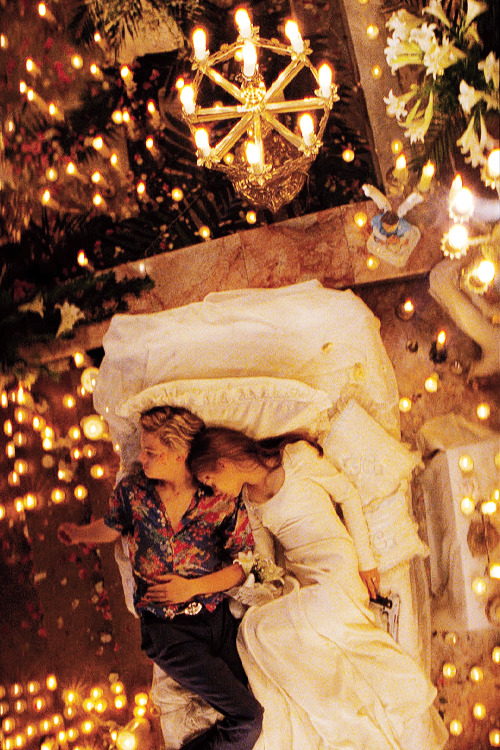
But the speed of their union doesn’t negate the intensity of those feelings. Had they lived, their love may have proved to be shallow and transitory, but their deaths immortalize it. Had the feud not existed, they probably would have dated and then broken up in a week. Had their love not existed, Verona would continue to be torn apart by civil war.
That’s the secret to Romeo and Juliet, the neatness with which the infatuation between these two teenagers had a lasting impacting on the world around them. Only the insanity that comes with Love at First Sight was enough to lead them to suicide, and by their suicides they heal the rift of their families and the city they live in. Well played, Shakespeare.
***
So what have we learned here? How can you pull off your very own example of Love at First Sight? Well, here are a few handy hints based on the above examples:
1. Make sure that the audience knows your characters are compatible, even before they’ve met each other. If the reader/viewer has a good understanding of who these characters are as individuals, they’ll be more willing to accept them as a couple in a limited amount of time. Do it right, and they’ll be desperate to see these two cross paths.
A relatively easy way is to have them partake in activities that reflect each other before they meet – for example, Baz Luhrman’s Romeo + Juliet had the two lovers submerge their faces in a sink of water at separate times, in separate locations. It forges a link between them, if only in the audiences’ minds.
2. Place it within an appropriate setting. If you’re writing a gritty crime drama, then no – you’re not going to convince anyone that your couple have fallen deeply in love within the space of a few seconds. If you’re writing a musical or a fairytale, then your audience will be in a much different frame of mind, and more willing to accept the unlikely nature of falling in love instantaneously.
Whether an anachronistic nightclub or a magical fairytale kingdom, a flamboyant backdrop makes for a suitable setting to an intense explosion of feelings.
3. Alternatively, make the moment of “love at first sight” a flashback that presents it as a pure fantasy or an idealized memory. Apparently the latter actually happens in real life, so it’s not that much of a stretch to have a mature character describe meeting their life-long partner in highly-whimsical terms. Even better, depict the couple several years into their marriage, proving that the relationship justifies the speed of the “falling” period.
4. Subvert it. No matter how high those hormones rage, no matter how intoxicating it all seems, reality will eventually ensue – but that doesn’t negate the power of how it feels at the time. Sometimes it’s strong enough to last, most of the time it isn’t, but that doesn’t mean that it’s not a story worth telling. Everyone’s had an infatuation that feels indistinguishable from real love, as in L.M. Montgomery’s Emily Climbs:
Before the evening was over Emily, for the first time in her life, had fallen wildly and romantically into the wildest and most romantic kind of love--"the love the poets dreamed of," as she wrote in her diary. The young man--I believe his beautiful and romantic name was Aylmer Vincent--was quite as madly in love as she.
He literally haunted New Moon. He wooed beautifully. His way of saying "dear lady" charmed her. When he told her that "a beautiful hand was one of the chief charms of a beautiful woman" and looked adoringly at hers Emily kissed her hands when she went to her room that night because his eyes had caressed them.
And then a truly terrible thing happened.
Emily fell out of love just as suddenly as she had fallen into it. One day she was, and the next she wasn't. That was all there was to it.
She was aghast. She couldn't believe it. She tried to pretend the old enchantment still existed. She tried to thrill and dream and blush. Nary thrill, nary blush. Her dark-eyed lover--why had it never struck her before that his eyes were exactly like a cow's?--bored her. Ay, bored her. She yawned one evening in the very midst of one of his fine speeches. Why, there was nothing to him but fine speeches. There was nothing to add to that.
She was so ashamed that she was almost ill over it.
5. Make it fun! Love at First Sight is so tightly linked with tragedies that it’s difficult to remember that it doesn’t necessarily have to be all doom and gloom. If your audience is charmed, or even better – laughing – at your couple’s meetcute, then you’ve got a better chance of winning them over. Geraldine and Harry have a great time together. So do Aladdin and Jasmine. That’s why the audience wants them to have an ending as joyful as their beginning.
4. Make it a Romeo and Juliet retelling, for this story is so entrenched within our culture that many readers (on recognising the familiar narrative) will simply shrug and go with it, understanding that sometimes Love at First Sight is a necessary plot device. You’ve seen it dozens of times before, from West Side Story to Gnomeo and Juliet. It's even been done with leprechauns and fairies. As long as there are two warring factions, the reader/viewer will understand what you’re trying to achieve.
And if you’re feeling daunted at adapting Shakespeare, remind yourself that it can’t possibly be worse than this version:
5. Don't use reincarnation as a short-cut to a hook-up. Trust me on this one. Unless you're willing to explore the ramifications of past lives and feelings that cross from one existence to another, it'll just come across as intensely lazy. Look at the recent take on Dracula starring Jonathan Rhys Meyers. Without any other justification they tried to sell Dracula/Mina as a couple because they were once married in a past life, and the whole thing just felt incredibly lazy as a result.
That's not to say that you can't write a story about lovers being reunited in past/future lives - just don't pretend it's interchangeable with Love at First Sight. Viewers need to feel the connection between two characters, and at least Love at First Sight is a trope that attempts to show us this. Reincarnation Romance needs a ton of backstory to demonstrate how these two souls came together in the first place, and therefore can't be squeezed into a limited time-frame.
They're completely different tropes that exist in completely different contexts, and you simply can't use reincarnation as a way of justifying Love at First Sight.
6. Finally, remember this... Love at First Sight can be at the very centre of your story or it can exist as a subplot, but either way, you must make sure that it is not the only thing your story is about. No matter how well you write your couple, no matter how many obstacles you put in front of them before them they can be together, Love at First Sight still runs the risk of feeling superficial – unless there’s something else going on.
Look at all the above examples and you’ll see that this is true. Geraldine had an important rapport with her congregation, Anna with her sister Elsa, Aladdin with the Genie – all of which inform the love stories, but don’t define them. Moulin Rouge was a bombastic musical, with a range of supporting characters all working together to make Spectacular, Spectacular! a hit show that celebrated their own Bohemian creed. Big Fish was more about Edward’s relationship with his son and the power of storytelling than Edward and Sandra's romance. And of course, Romeo and Juliet died to end the terrible feud between their households.
There should always be more at stake than just the lovers.
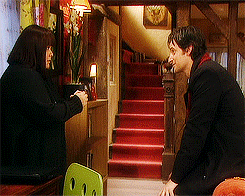
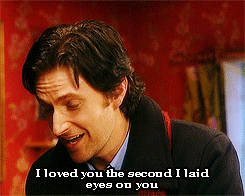



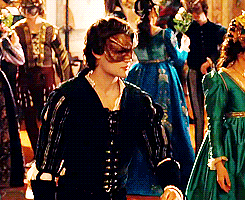
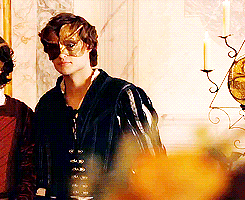
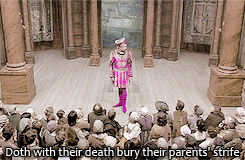







Great post! I really like this Tropes project of yours.
ReplyDeleteWith regards to the point you made about reincarnation, have you ever seen Inuyasha? I don't know if anime is at all up your alley, but Inuyasha plays the reincarnation angle really, really well, imo. Personally I think it'd be well worth watching the pilot, at least, which is a superb episode and one I've seen over ten times.
I don't watch much anime, though I don't actively avoid it either, so I'll keep my eyes out for Inuyasha. Reincarnation is a fascinating subject when it's done well, so I'd probably end up enjoying it.
DeleteThis comment has been removed by a blog administrator.
ReplyDeleteI was so delighted to meet PRIEST AZIBA after a long time looking for help in order to fix the ups and downs with my boyfriend. We lived together for two years without any problems until this year when he started seeing another girl, When I tried talking to him, he decided to leave me for her which made me so heart broken after all we have been through together, he even stopped picking up my calls and also blocked me from calling him. I love him dearly and couldn't accept losing him that's why I decided to seek help from PRIEST AZIBA through his WhatsApp number +2348100368288, he helped me quickly in one day and as I speak my boyfriend is back to me with lots of love and respect like never before. Am expecting more good things to happen in our relationship.
ReplyDeleteGet in contact with PRIEST AZIBA and He's also specialize in giving lottery winning numbers spells, Herbal Medicines E.T.C. Get connected Email: priestazibasolutioncenter@gmail.com Or WhatsApp : +2348100368288